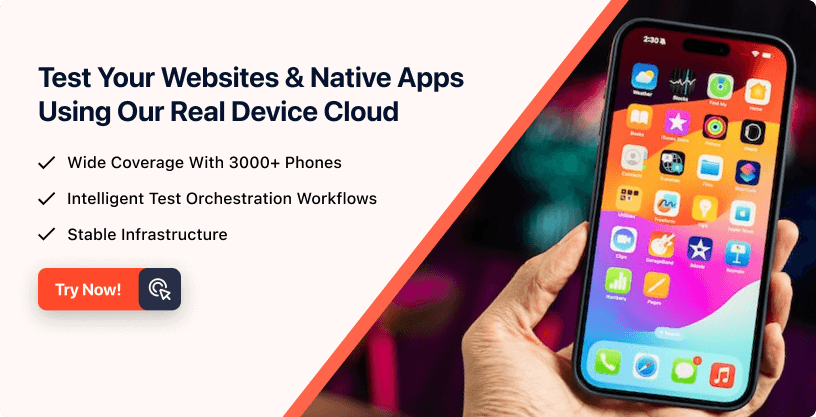A/B Testing: A Comprehensive Guide With Examples
- Learning Hub
- A/B Testing: A Comprehensive Guide With Examples
OVERVIEW
A/B testing involves comparing two versions of a website or app against each other to determine which performs best. In this experiment, two or more variants of the same page are shown randomly to users, and statistical analysis determines which variation performs best.
There are a lot of businesses today that are unhappy with the unqualified leads they get per month. E-Commerce stores are struggling with a high cart abandonment rate. The media and publishing houses are also dealing with low customer engagement. Conversion metrics have impacted the overall business growth of different industries.
This is where you need A/B testing that helps improve the overall growth metrics and end-user engagement and experience.
What is A/B testing?
A/B testing is a basic way to perform an experimentation process to compare two or more versions to determine which version leaves the maximum impact and drives business metrics. Two or more versions of a webpage, page element, etc., are shown to the website visitors simultaneously so they can choose the best.
In A/B, ‘A’ represents the original version of the element, whereas ‘B’ refers to the variation or a new version of the original testing variable. A/B testing helps to eliminate all the guesswork from the equation and enables experienced optimizers to make data-backed decisions in a product and marketing strategy.
It means that you can make business decisions backed by comprehensive data analysis. Whether you are a designer, business analyst, or developer, you can always rely on the A/B testing results and become more data-driven in your working approach.
It started in the 1920s when the statistician and biologist Ronald Fisher discovered some key principles behind A/B testing. Still, it was in the 1990s that this concept came into existence.
Here are some scenarios where you can run A/B tests.
- Call to action button
- Website performance
- Page headlines
- Position of different elements on the web page
- Product descriptions
- Email marketing
A/B testing involves three key elements.
- Campaign: This can be an ad, landing page, or any medium already used.
- Elements: The elements that need to be tested.
- Defined goals: The goals that you tend to achieve in the long run.
Additionally, A/B tests lets you know what words, phrases, images, or design elements work best. Even the smallest of changes can impact metrics and growth. You can execute changes that are relatively inexpensive to implement. You can test 2 to 3 elements and get the desired answer. Also, it can help you easily decide whether to implement that change. You can always revert to the older version if the testing results are incorrect.

Why should you perform A/B testing?
B2B businesses always face challenges with all the unqualified leads, and eCommerce stores struggle with a high cart abandonment rate. This impacts their business metrics in the long run.
Here are some of the top reasons you should prefer A/B tests for your growth strategies.
- Solve user's pain points: Users visit your website because they have a specific goal they need to accomplish. It may be related to understanding a specific product or service, buying a particular product, or simply browsing the product catalog. Whatever the visitor’s goal, they may face some pain points in achieving their desired goal.
- Get a better ROI from the existing traffic: It is always a challenging task when trying to acquire quality traffic on your website. This is when you can rely on A/B test that helps improve conversions without spending additional money on acquiring new traffic. It provides high ROI helping you to improve your business growth.
- Making minor modifications to the software application: A/B test allows you to make minor and incremental changes to your web page rather than drastically improving the page design and layout. This ensures that your current conversion rate remains intact. You can perform A/B tests to gauge user behavior when minor modifications are performed.
- Achieve improvements in the long run: Since A/B tests is a data-driven approach where you do not have to rely on guesswork or instincts, and that is why you can quickly determine the right version based on different predefined metrics. This allows you to bring improvements that are great for your business’s growth in the long run.
It could be due to the CTA button not being visible or maybe in a confusing place for the user to click. When they cannot achieve your desired goals, the end user experience is impacted. You can gather data using heatmaps and Google Analytics to solve your visitor’s pain points.
Let’s consider the two versions of a landing page you need to test for an e-commerce website. The traffic is split randomly so that one group of the website audience views version A, and the other group sees version B of the landing page.
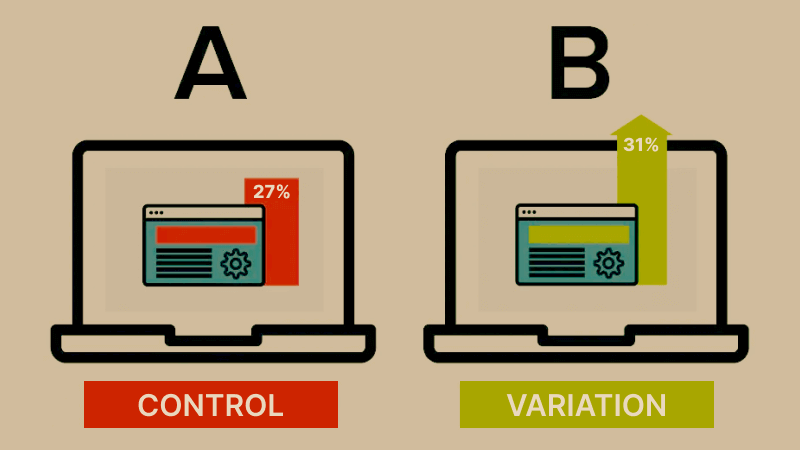
Different metrics, such as time spent during each session, conversions, etc., are calculated and tracked to gauge which version works the best for the website users. This is how you can effectively use A/B tests to determine which version helps you to achieve desired business growth in the long run.
Types of A/B testing
There are three types of A/B tests you should know about.
- Split testing: In split testing, you can test a completely new version of an existing web page to see which version performs better. It is a great way to test an existing page's design and copy without changing anything else.
- Multivariate testing: This type of A/B testing involves simultaneously testing variations of multiple variables on a page to determine which combination performs best. Since this method involves creating many variant pages, it ideally suits advanced marketers, product developers, and designers.
- Multi-page testing: It involves testing changes to particular elements, such as the CTA button, across multiple web pages.
Skills required for A/B testing
A/B testing can be challenging if you do not have the right resources to implement it. That is why you need exceptional testing professionals or specialists that can derive valuable insights and make required design corrections to your website or webpage.
Some key skills required for it.
- Expertise in testing multiple platforms and systems.
- Understanding the different data requirements and performing detailed analysis.
- Knowledge related to user experience design where you understand different design elements and how they interact within the system.
- Social media marketing and campaigns.
- User interviews to derive valuable insights from your users who are using the product.
Who performs A/B testing?
A/B testing allows teams and organizations to change their user experiences while collecting data from the testing results. It is focused on improving the growth metrics, which are specific to the company’s goals and objectives.
It can be performed by either of the following teams that are aware of the end-to-end functionality flows:
- UX team
- QA team
The respective teams can try A/B tests changes to the form fields, headline, call to action, and overall page layout. In some companies, the UX and QA teams can collaborate closely to perform it.
That is why it becomes important talking to your customers so that you can easily identify the specific aspects that need improvement. The right approach is to make small design changes and observe customer behavior.
Real World Example of A/B testing
Let us discuss how tech giants like Netflix, Amazon, etc., use A/B test to achieve desired business goals and customer growth.
Netflix is well known for providing its users with the best-in-class streaming experience. But everyone is unaware that it relies heavily on A/B tests. Even today when it sees a dip in customer engagement and retention. Every change done on the Netflix website goes through an A/B test process. One such example of it is the personalization feature which is shown on the home page. Based on every user profile, the user personalization experience is defined. This is applicable in the case of media as well.
When we talk about the eCommerce industry, no other brand like Amazon provides an amazing end-user experience. This is evident in the buying functionality as well. Amazon used A/B tests to define the call-to-action button for improving the overall shopping experience since it has a huge business impact on the sales and revenue of the company.
A/B tests is also a useful option in the travel domain, especially when planning to increase the existing bookings or improve the existing revenue. Booking.com quickly realized the true value of it. The users of this organization were executing tests based on the finalized ideas.
Benefits of A/B testing
With A/B test, you can directly test your hypothesis on a target audience segment. This will ensure that any changes you make to your website are based on strong evidence. Some of its advantages are.
- Improve your website's visitor experience and conversion rate continuously.
- Ensure your visitors have an exceptional user experience to keep them around your brand.
- Understand the needs and expectations of your visitors by analyzing how your pages are structured.
- It helps you make better decisions by testing your assumptions and reducing risk factors.
- When making decisions, avoid subjective assessment. Instead, test your hypotheses and reduce risks by collecting reliable facts and statistics.
Drawbacks of A/B testing
Here are some of the disadvantages of using A/B tests.
- Involves a lot of time and resources. There is a significant amount of time spent setting up the process, even though you can use third-party services. There can be endless meetings before you conclude. A/B tests can take weeks or even months for low-traffic sites.
- If you already have usability issues with your website, then you cannot expect that the A/B tests can help you achieve the desired results.
- It cannot help you to determine why people perform a certain set of actions. You are not observing the users or their thought processes but relying on statistics to arrive at the results.
- It is not a comprehensive UX method such as usability testing, where you can identify potential issues in the overall system design. It works on the data elements that are being tested.
Statistical approaches for A/B testing
To perform A/B tests successfully and draw the right business conclusions, you must understand which statistical approach to use. Most A/B/n testers use Frequentist or Bayesian statistical approaches.
Let's understand these two approaches.
- Frequentist approach: You can determine the reliability of your results by checking the confidence level. If it is above 95%, you have a 95% chance of being accurate. However, this method comes with a drawback. Due to its "fixed horizon", the confidence level does not have any value until the test ends.
- Bayesian approach: With this approach, you know what is likely to happen at the beginning of the test, so you can identify trends and interpret the data immediately. However, this method has its challenges. You need to understand how to interpret confidence intervals. As the number of conversions increases, the probability of a reliable winning variant increases.
Steps to perform A/B testing
This section will discuss the steps to run an A/B test in sequential order.
- In-depth research and collect data requirements: You need to be intelligent and proactive about your testing requirements. The best way to do it is to do an in-depth analysis and study your current analytics trend.
- How is the site performing?
- How are we meeting our business goals and objectives?
- What are the key performance metrics, and how are they tracked?
- How can we bring overall improvements in site traffic and user growth?
- Finalize a goal: Once the research phase is over, it is about finalizing your goal and ensuring you achieve it. You can set goals based on the organization’s growth prospects. The goals can vary, but they should be clearly defined and measured. Some goals that can be accomplished are:
- Improve business growth
- Increase customer engagement
- Increase the existing website traffic
- Create a hypothesis: With the final goal, it is time to invest your time and effort toward creating a hypothesis for your A/B tests. This is required to perform the right testing on the required elements to get the desired outcomes. You can opt for multiple hypotheses but can pick and choose which ones to take up first based on the priorities.
- Estimate different factors related to A/B tests: You can estimate key factors related to your tests, including the sample size where you evaluate the total number of visitors that need to pick up for the experiments. You can also calculate the total number of days it will take to conduct A/B tests.
- Determine the target audience for A/B tests: It is important to determine the target audience on which the A/B tests need to be performed.
- Create variations: You can create different variations of the element once you are aware of the testing scope and the target audience that are part of this testing process.
- Run tests: Now you are ready to run the required tests after creating different variations on which the tests need to be performed.
- Result analysis: This is one of the key phases. It is about evaluating the test results to see which aspects are doing well and which ones need improvement in the long run. It is about taking constructive actions based on the result analysis.
You need to answer some common questions:
You can then define the A/B tests once you get clarity on the overall business trends and growth metrics. You can observe the trends related to top-performing pages and how you can bring much-needed improvements to the pages that need to meet the desired expectations. Once the research is done and you have collected the required data points, it is time to finalize a goal.
In the absence of a goal, there is no point in starting A/B tests. Once the goal is finalized, it is about creating a hypothesis to take it forward.
Apart from performing the above sequential for A/B tests, you can also perform the following key things to ensure that your business growth improves shortly.
- Keep the landing page simple, where the page load time is within seconds.
- You can connect personally with your customers and end users by introducing videos that add value.
- You can talk to new customers and ask them what made them sign up with valuable features that add value.
- You can change the heading style and content to see how it impacts the subscribers.
- You can change the pricing model to see the customer’s response.
- Make the sign-up form super short by removing extra details.
Mistakes to avoid during A/B testing
These are some common mistakes you can avoid so that it does not hurt your business growth.
- A/B tests should never be performed on predefined assumptions.
- It is important to formulate a hypothesis before conducting A/B tests. All subsequent steps are based on hypothesis, which is why creating the wrong hypothesis can prove costly with inaccurate results.
- It is not recommended to consider someone else's test results for your website or webpage.
- You are not required to run too many tests simultaneously. Testing too many elements too quickly is not a good practice because you will not be able to evaluate the performance of every element that impacts success or failure.
- It should be performed with the right traffic to get desired results.
- Running a test for a too-long or too-short period can result in the test failing or producing insignificant results. The duration to run the tests is decided on various factors such as existing traffic, current conversion rate, etc.
- Performing it with faulty tools can impact the performance of your website. It is important to pick and choose the right tools.
- A/B tests is an iterative process; you need to derive key insights from the last tests when planning your next test.
Challenges with A/B testing
Here are some of the major challenges that are faced during A/B testing.
- You must decide on the testing scope because it is all about choosing the right elements. Since there are so many website elements to choose from, you might find yourself unable to decide which elements to be given the top priority during testing so that it helps to improve the growth metrics. You can identify the most visited websites or web pages because this is where you will get the maximum benefit when you are performing your testing activity.
- Finalizing the sample size, which should be decided based on website traffic. It is important to finalize a sample size that covers a large set of users so that effective results can be obtained from A/B testing.
- Maintaining an iterative testing environment where you keep improving and getting better. That is why you need to maintain an environment that can help you achieve the desired outcomes.
- It is not a good practice to frequently bring changes to your A/B testing. This will impact the final results, but the teams won’t be motivated enough to perform this activity in the near future as it takes up a significant amount of time and effort.
Tools for A/B testing
There are two different tools that you can use for A/B testing:
- Quantitative A/B testing tools.
- Qualitative A/B testing tools.
Let us discuss both of these categories in more detail.
Quantitative A/B testing tools
These tools rely on the data requirements and user insights during the A/B test. These types of tools help gather required data points numerically.
The following quantitative tools are used for A/B testing.
- Google Optimize
- VWO
- Omniconvert
Qualitative A/B testing tools
These tools rely on user experience, product experience insights, and user patterns, where you explain the user behavior while performing specific actions. These tools are useful when you need to achieve advanced insights from A/B testing.
The following qualitative tools are used for A/B testing.
- Hotjar
- Usersnap
- CrazyEgg
Performing A/B tests outside the production environment is impossible as they can only be successful with real users. It provides valuable feedback for developers, testers, and other stakeholders when performed effectively. Production environments should be real devices and browsers. Emulators or Simulators cannot replicate real user conditions and should not be considered a viable option for testing.
This is where cloud-based testing platforms like LambdaTest help you with A/B testing.
LambdaTest is a continuous quality cloud platform that lets you perform web and mobile app testing on over 3000 real browsers, devices, and OS, accessible from anywhere and anytime. It enables you to make manual and automation testing requirements seamless by utilizing cloud capabilities. When you test different features and functionalities on the cloud, you tend to manage testing requirements much better. You can attain better browser coverage with the variety of options supported by this platform.
It also provides a real device cloud to help you test web and mobile applications in real-user conditions and get accurate test results.
Subscribe to the LambdaTest YouTube channel for test automation tutorials around Selenium, Playwright, Appium, and more.
How to perform A/B testing using the LambdaTest platform?
LambdaTest helps you perform A/B testing of your websites and mobile apps on a real device cloud. Using this platform, you can perform real-time or automated testing for your testing needs across different browsers and OS combinations.
Apart from manual and automated testing, there are various features that the LambdaTest cloud platform offers, like visual regression testing, responsive testing, screenshot testing, and more.
For now, we will discuss real-time testing and automation testing.
Real-time testing
LambdaTest gives you the power to perform live-interactive testing that will help you deliver error-free software applications as you perform tests to check the intended functionality of features on your website as an end user in real time.
Below are the steps to perform real-time testing on LambdaTest.
- Sign up for free and login to your LambdaTest account.
- From the left sidebar menu, go to Real Time Testing > Browser Testing.
- Enter the website’s URL, and select a desktop or mobile device. If you want to test on a desktop, choose the RESOLUTION, OS, and VERSION of the browser. Then, click START.
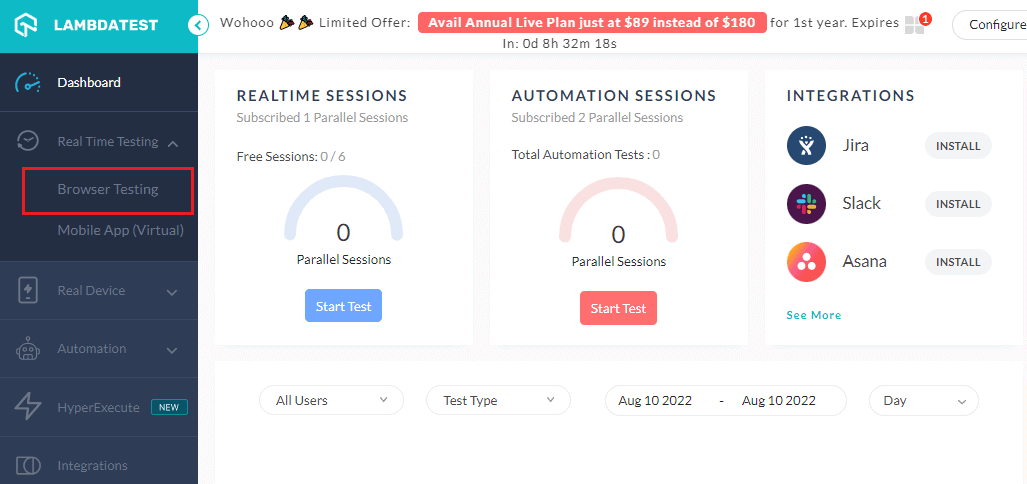
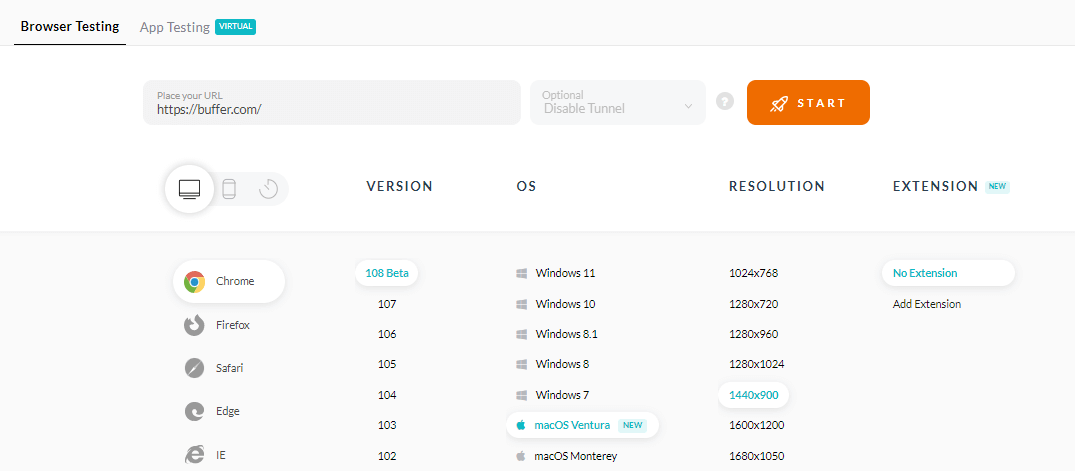
A cloud-based real operating system will spin up where you can run A/B tests of your web or mobile apps.
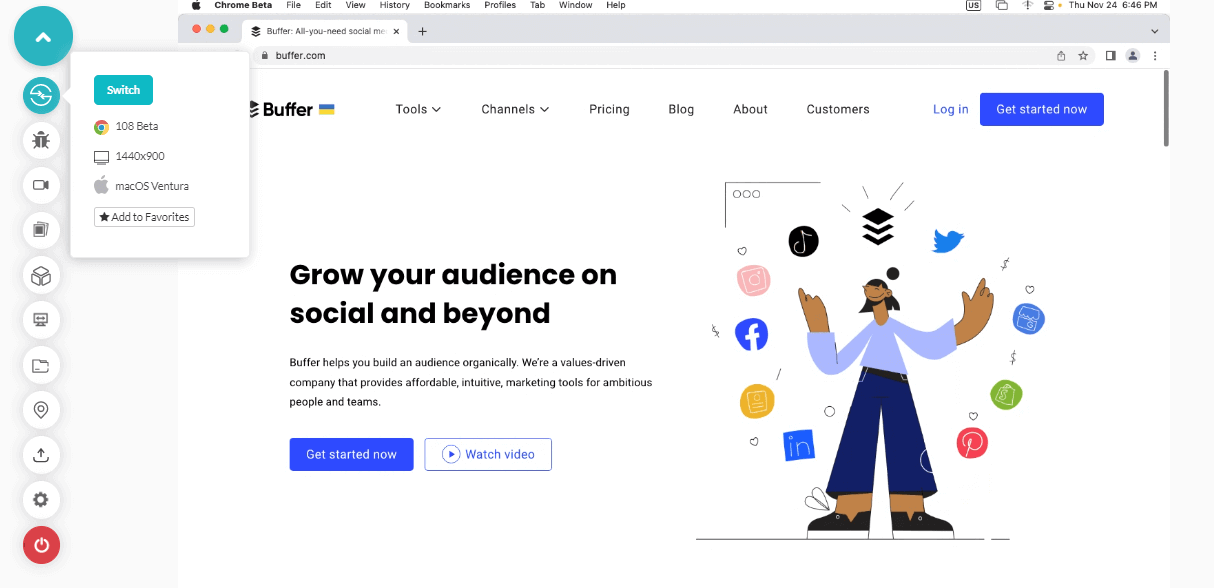
Automation testing
Besides real-time testing, you can perform automation testing for your websites or mobile apps. You can run automated tests using Selenium, Cypress, Playwright, Appium, and more.
Check out the steps to perform automated A/B testing using the LambdaTest platform.
- Login to your LambdaTest account.
- From the left sidebar menu, go to Automation > Builds.
- Choose your favorite programming language and testing frameworks and start automating your repetitive A/B test cases.
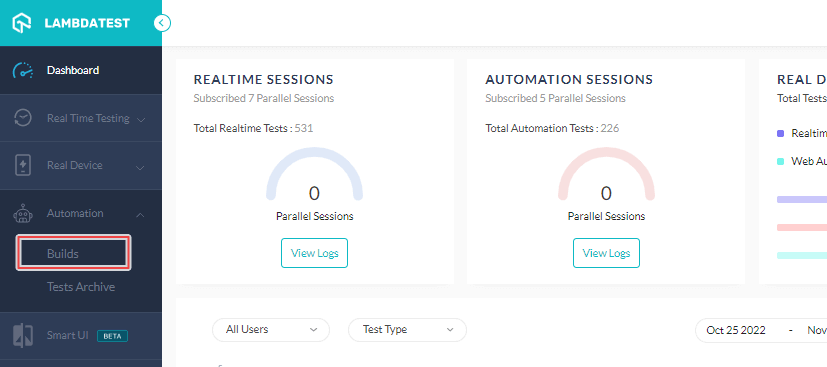
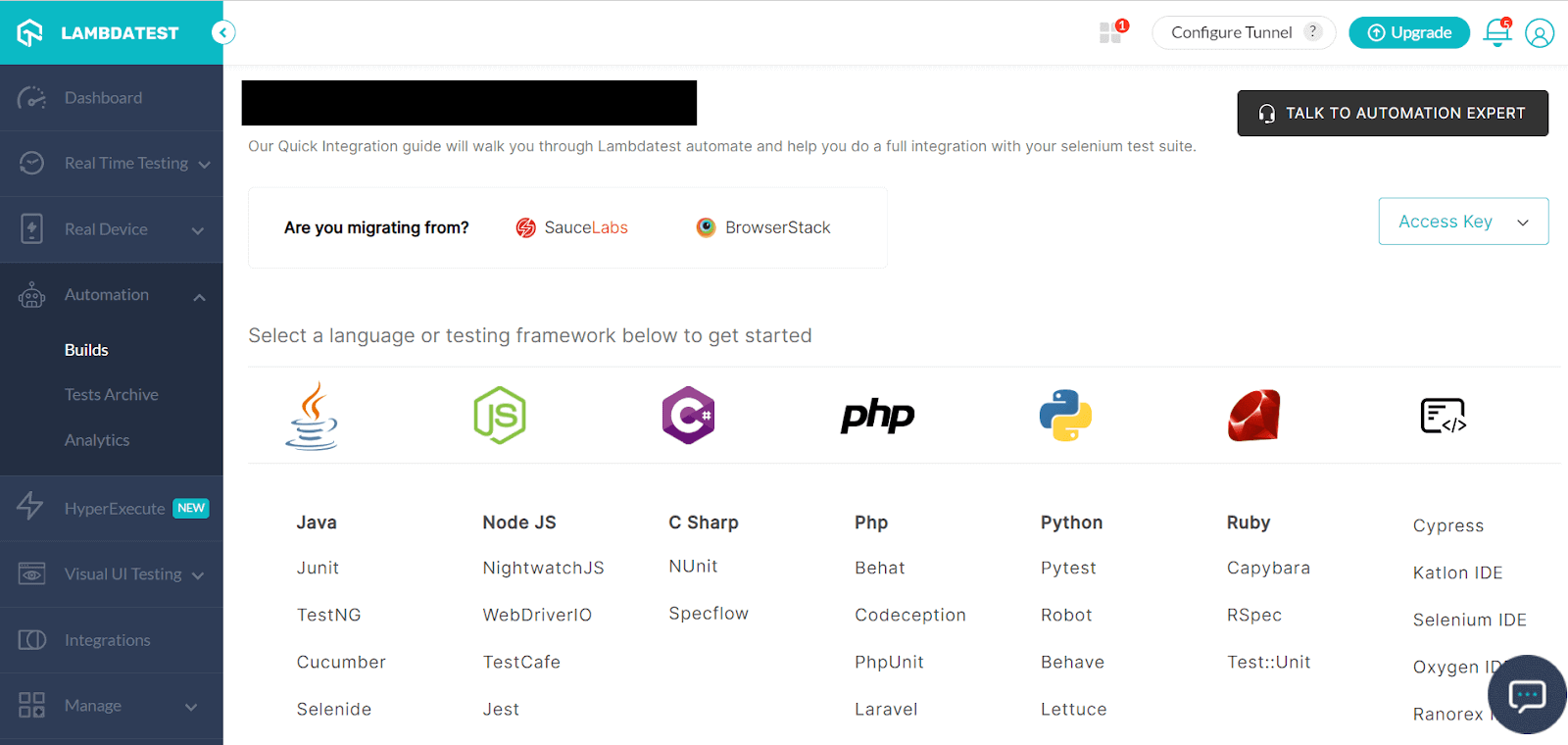
Analyzing A/B testing results
We can have structured processes to perform A/B testing, but the important aspect is to analyze the A/B Testing results. It is more complex than you could imagine. You can follow the below pointers:
- Basic analysis: Check the A/B test results to identify the clear winner. You can perform basic analysis using Google Analytics, which helps you make better decisions based on data trends and more informed decisions.
- Analysis of secondary metrics: While the winner is evaluated based on the primary metrics, you can also measure the performance using secondary metrics as well. You can analyze secondary metrics if the initial analysis does not provide exact results.
- Audience breakdown analysis: You can break your results based on the audience.
- Evaluate past data: You can archive or revisit the past data from A/B tests to analyze testing results.
Best Practices of A/B testing
Here are some of the best practices you can follow when doing A/B testing.
- The testing results tend to suffer if you do not define the sample size right from the beginning. If you do not perform tests for enough people, you won’t get reliable results.
- You can choose the required A/B testing tools based on the variables that need to be tested.
- It is always a good practice to preserve your test results in a centralized location so that different teams in the future can refer them.
- Test the right items that make a difference to your business and growth metrics.
- Make sure that your data set is reliable and authentic.
- Get your hypothesis right from the start.
- Schedule your test results correctly.
- Finalize the test duration, as it plays an important role in determining the reliability of the test results.
- Do not try to introduce mid-test changes.
- Test one element at a time.
- Keep variations under control.
- Pay close attention to the data.
Summing up
After reading the detailed guide on A/B testing, you should now be fully equipped to plan your A/B testing requirement considering the challenges and blockers. It is important to understand the true value of improving your website’s existing traffic and growth; cloud testing platforms like LambdaTest allow you to simplify A/B testing, where all the infrastructure and test configurations are handled seamlessly on the cloud.
There is no denying that if you implement A/B testing with complete knowledge and dedication, you will observe your existing design elements improving and have the most optimized version of your website.
Frequently Asked Questions (FAQs)
What are the types of A/B testing?
There are three types of A/B tests: Split testing, Multivariate testing, and Multi-page testing.
Why do we do A/B testing?
There are many benefits of A/B testing, including increased user engagement, reduced bounce rates, increased conversion rates, and more. And performing an A/B test can positively affect your website or mobile applications.
Author's Profile

Irshad Ahamed
Irshad Ahamed is an optimistic and versatile software professional and a technical writer who brings to the table around four years of robust working experience in various companies. Deliver excellence at work and implement expertise and skills appropriately required whenever. Adaptive towards changing technology and upgrading necessary skills needed in the profession.
Reviewer's Profile

Salman Khan
Salman works as a Digital Marketing Manager at LambdaTest. With over four years in the software testing domain, he brings a wealth of experience to his role of reviewing blogs, learning hubs, product updates, and documentation write-ups. Holding a Master's degree (M.Tech) in Computer Science, Salman's expertise extends to various areas including web development, software testing (including automation testing and mobile app testing), CSS, and more.
 Christmas Deal is on: Save 25% off on select annual plans for 1st year.
Christmas Deal is on: Save 25% off on select annual plans for 1st year.